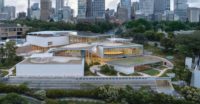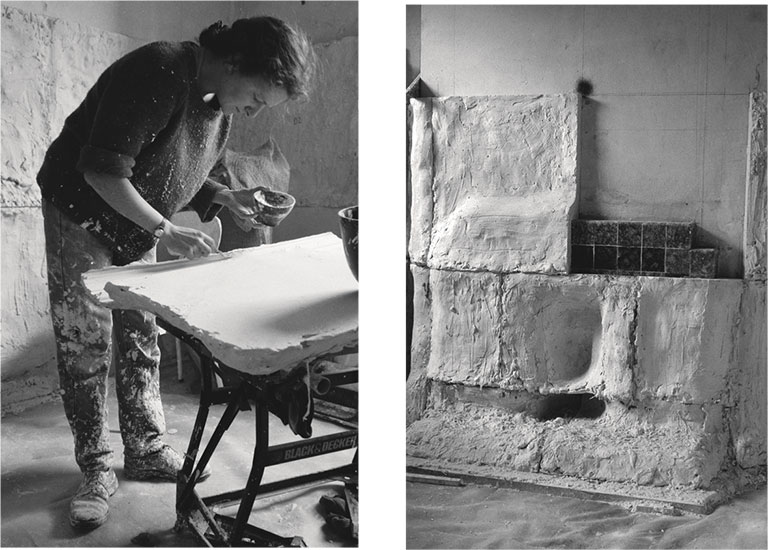On the night of November 23, 1993, artist Rachel Whiteread received awards for being both the U.K.’s best artist and its worst. She won the Turner Prize, the Tate Britain’s £20,000 award for top emerging visual artists in the U.K.; but she also garnered a far more dubious distinction: the “Anti-Turner Prize,” which was drawn from the same shortlist as the real Turner prize and included a purse of £40,000, from a group called the K Foundation, who sought to recognize Whiteread as the worst artist in the world. Both prizes related to Whiteread’s highly controversial “House” installation—a life-sized cast of a Victorian East End house, rendered in spray-on concrete.
The same night, in between receipt of the two prizes, Whiteread learned that “House” itself would also be demolished in the name of redevelopment. Although it stood for only 80 days, the piece stirred debate about artists dabbling in architecture as well as the broad trend toward gentrification. Public opinion of the piece at the time ranged from eyesore to masterpiece, with the dual awards reflecting the extreme positions.
A quarter of a century later, Whiteread’s work has continued to accumulate honors, and a retrospective exhibition of her works—titled Rachel Whiteread—from the last 30 years shows a progression of spatial and textural investigations that expand upon themes explored in “House.” Launched at the Tate, the exhibition stopped in Vienna before making its American debut on September 16 at the National Gallery of Art in Washington, D.C. Following the show’s four-month run in the capital, it will open at the Saint Louis Art Museum in March 2019.
At the base of the crisscrossing staircases and bridges of the National Gallery’s East Building, designed by I.M. Pei, a sculpture by Whiteread reaches upward in the atrium, as if to offer an alternative means of gallery ascent. This piece, “Untitled (Domestic),” emphatically marks the entry to the exhibition, rising 22 feet as the plaster-encased negative space of a fire stair. The idea of transforming voids into solids pervades Whiteread’s oeuvre, and the show displays her career-long exploration through careful, repetitive imprints of everyday objects rendered in a variety of media.

The gallery opens across a field of 25 colorful resin figures—of variable dimensions but all roughly cubic—representing the space beneath assorted chairs. Another room showcases domestic items from her first solo show in 1988 staged around a cast of a whole room, dubbed “Ghost,” (1990). The scalar shift from object to room would lead to her Turner- and Anti-Turner-winning cast of a whole building in 1993.
More recent commissions have included a shed-sized installation on Governors Island (“Cabin,” 2016) and a site-specific installation for the U.S. Embassy in London (“Flat Pack House,” 2017), but the exhibition alludes to these and other larger works minimally; rooted in their respective sites, they travel with this show in the form of a single photograph for each. Still, the breadth of smaller objects, such as a shelf’s worth of casts of toilet paper rolls, is astounding; medium-sized figures that include studies of doors, windows, packing boxes, and bathtubs likewise accumulate across the gallery floors, except for one portion of floor dedicated to a cast of a kitchen floor, complete with an inverted drain hole. Her catalog includes such a variety of quotidian hardware that it appears almost as an architectural salvage yard, except with door handles indented instead of protruding.
One of the highlights of the show is “Untitled (Book Corridors),” from 1997, which is, once again, a better representation of what’s not there than what is: The books were cast in plaster, then removed, but traces of their covers remain, lending hints of color to imply their presence and to makes memories solid, as Molly Donovan, who co-curated the exhibition with (the Tate’s Ann Gallagher, explains). “Texture is very important to Whiteread, because that’s what enables her to suggest the form she started with for the viewer,” Donovan says. “That’s her way of giving people a grounding in what they’re looking at.”
In this case, viewers can expect to see familiar objects with Freudian hints of the uncanny and unfamiliar, as with a room rendered inside out, the imprinted door handles, or an inverted staircase that would be daunting to climb. Through her decades-long continuous investigation and refinement of process in solidifying emptiness, Whiteread seems to have cemented her place, 25 years later, as one of the world’s best artists.
Rachel Whiteread is on view at the National Gallery of Art East Building from September 16, 2018 – January 13, 2019.






















